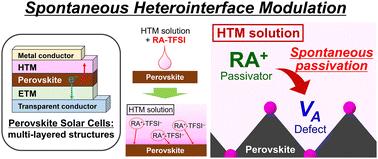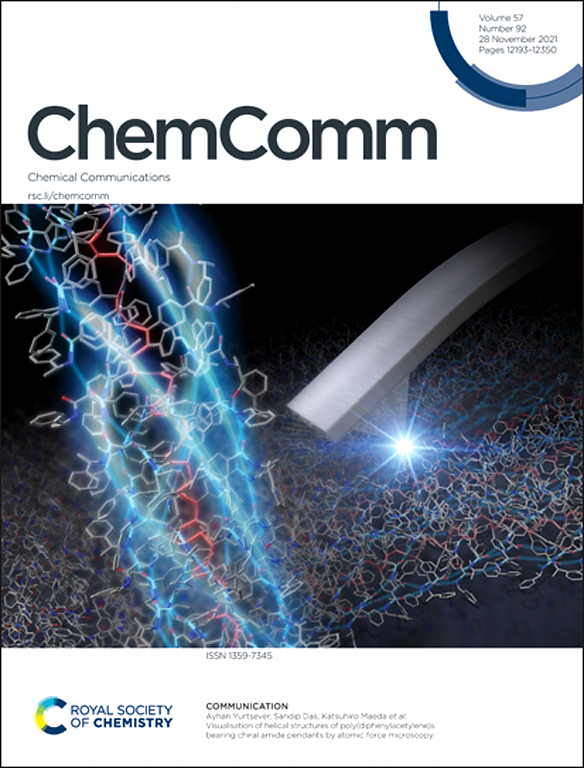钙钛矿太阳能电池的自发异质界面调制器
IF 4.2
2区 化学
Q2 CHEMISTRY, MULTIDISCIPLINARY
引用次数: 0
摘要
钙钛矿太阳能电池(PSCs)因其优异的光伏(PV)性能而备受关注。当与p型空穴传输材料(HTM)和n型电子传输材料(即n-i-p或p-i-n结构)夹在一起时,它们的多层结构有助于在i型类钙钛矿光吸收剂中进行有效的电荷分离,从而实现高PV性能。由于异质界面容易产生作为载流子陷阱的缺陷,因此在psc中调制它们是至关重要的。本文综述了新兴但有效的自发异质界面调制技术,以及自发异质界面调制器(SHMs)的有效性。SHMs用作PSC组分前驱体溶液的添加剂(例如,钙钛矿前驱体溶液和HTM溶液),并且可以绕过传统的异质界面调制处理;SHMs可以提高PSC制造的工艺效率。此外,shm可以有效地调节埋藏界面,降低由大气污染引起的缺陷形成的风险。此外,一些shm还提供了传统的分步异质界面调制无法实现的额外好处。重点介绍了烷基伯胺基离子液体(RA-TFSIs),这是一种为PSC应用而设计的新型离子液体,可作为HTM添加剂。在钙钛矿层上沉积含有RA- tfsi的HTM溶液时,RA阳离子自发地钝化钙钛矿层,产生独特的效益,这可以通过RA阳离子的分子结构来调节。此外,新兴的ra - tfsi已经显示出超越psc的前景,因为它们的成分偏离了目前主要的离子液体,为各种尚未开发的应用开辟了道路。因此,本文将对材料科学的进一步发展起到指导作用。本文章由计算机程序翻译,如有差异,请以英文原文为准。

Spontaneous heterointerface modulators for perovskite solar cells†
Perovskite solar cells (PSCs) have attracted significant attention owing to their prominent photovoltaic (PV) performance. Their multi-layered structure facilitates efficient charge separation in i-type-like perovskite photoabsorbers when sandwiched with a p-type hole transport material (HTM) and n-type electron transport material (i.e., n–i–p or p–i–n structures), enabling high PV performance. Since heterointerfaces are prone to creating defects that act as carrier traps, modulating them in PSCs is crucial. In this review, the nascent yet potent spontaneous heterointerface modulation techniques, and effectiveness of spontaneous heterointerface modulators (SHMs) are highlighted. SHMs are used as additives for precursor solutions of PSC components (e.g., perovskite precursor solutions and HTM solutions) and can bypass the conventional treatment of heterointerface modulations; SHMs can increase process efficiencies of PSC fabrications. Additionally, SHMs can effectively modulate buried interfaces, reducing the risk of defect formation caused by atmospheric contamination. Furthermore, several SHMs serve additional benefits that the conventional step-by-step heterointerface modulation cannot attain. In particular, alkyl-primary-ammonium-based ionic liquids (RA–TFSIs), which are a novel series of ionic liquids designed for PSC applications and used as HTM additives, are highlighted. During the deposition of HTM solutions containing RA–TFSIs on perovskite layers, RA cations spontaneously passivate the perovskite layers, generating unique benefits, which can be tuned via the molecular structure of RA cations. In addition, emerging RA–TFSIs have shown promise beyond PSCs, as deviation of their components from the currently major ionic liquids opens avenues for diverse applications that have remained unexplored. Therefore, this review will guide further development of materials science.
求助全文
通过发布文献求助,成功后即可免费获取论文全文。
去求助
来源期刊

Chemical Communications
化学-化学综合
CiteScore
8.60
自引率
4.10%
发文量
2705
审稿时长
1.4 months
期刊介绍:
ChemComm (Chemical Communications) is renowned as the fastest publisher of articles providing information on new avenues of research, drawn from all the world''s major areas of chemical research.
 求助内容:
求助内容: 应助结果提醒方式:
应助结果提醒方式:


